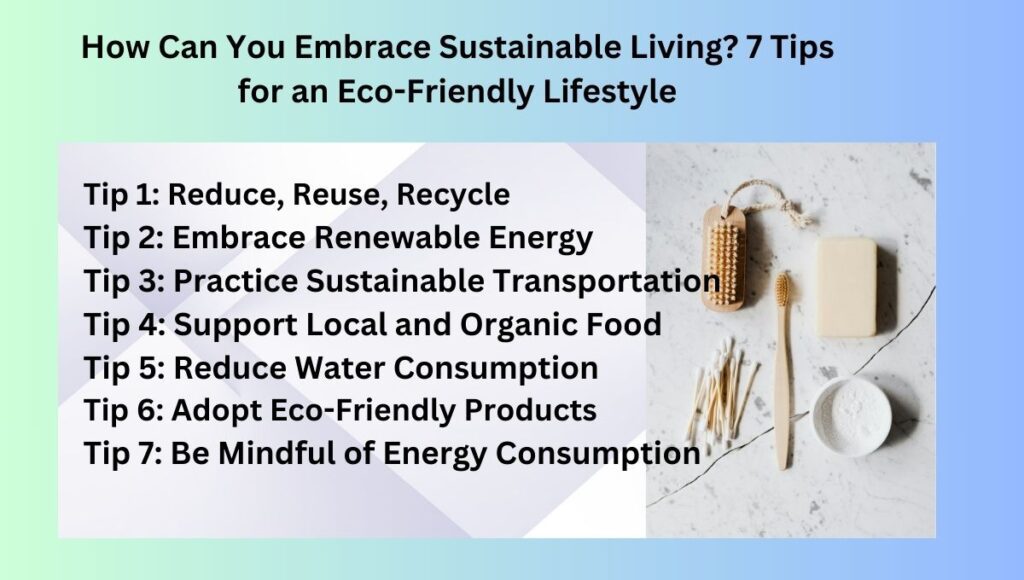How Can You Embrace Sustainable Living? 7 Tips for an Eco-Friendly Lifestyle
Table of Contents
ToggleIntroduction
“Sustainable living is not just a phrase; it is a lifestyle choice with the potential to improve the health of our planet significantly. But what does it mean to live sustainably, and why should we care? In this age of climate change, pollution, and dwindling resources, adopting an eco-friendly lifestyle has never been more crucial. This article will guide you through seven practical ways to live more sustainably, reducing your environmental impact while improving your quality of life.”
What is Sustainable Living?
Understanding the Concept
Sustainable living is all about making choices that are good for the environment, society, and economy. It involves adopting practices that reduce your carbon footprint, minimize waste, and promote the well-being of both people and the planet. In simple terms, it means living in a way that allows future generations to enjoy the same resources and quality of life that we do.
Benefits of Sustainable Living
Embracing sustainable living comes with a multitude of benefits. Not only does it contribute to the preservation of our environment, but it also promotes better health, saves money, and supports local communities. When you choose sustainable practices, you’re investing in a better future for everyone.
How can I make my lifestyle more eco-friendly?
To make your lifestyle more eco-friendly, start by making small, impactful changes such as reducing waste, using reusable items, and recycling. Choose energy-efficient appliances, conserve water, and opt for sustainable transportation methods like walking, cycling, or public transit. Supporting local and organic foods, reducing meat consumption, and using eco-friendly products also contribute to a greener lifestyle. Every small step counts towards reducing your environmental footprint and promoting a healthier planet.
Tip 1: Reduce, Reuse, Recycle
The Importance of Reducing Waste
The first step in living sustainably is reducing the amount of waste you produce. By being mindful of what you consume and choosing products with minimal packaging, you can significantly cut down on the waste that ends up in landfills.
How to Reuse Everyday Items
Before discarding items, think about repurposing them. Convert old jars into storage containers and use worn-out garments as cleaning rags to reduce waste and save money.
Effective Recycling Practices
Recycling is an essential component of sustainable living. It’s important to familiarize yourself with your local recycling guidelines and always rinse out containers before recycling them. Proper recycling helps keep valuable materials out of landfills and in use.
Tip 2: Embrace Renewable Energy
The Role of Renewable Energy in Sustainable Living
Renewable energy sources, like solar and wind power, are key to reducing our reliance on fossil fuels. By embracing renewable energy, we can significantly cut down on greenhouse gas emissions and move towards a more sustainable future.
Solar Power
Solar power is a readily available form of renewable energy. Installing solar panels on your home can lower your electricity bills and decrease your carbon footprint. Even if you’re unable to install panels, supporting solar energy projects is a great way to make a difference.
Wind Energy
Wind energy is another powerful renewable resource. Although it may not be feasible for individual households, supporting wind energy projects through your utility company can make a big difference.
Other Renewable Energy Sources
In addition to solar and wind, there are other renewable energy sources worth considering, such as geothermal and hydroelectric power. Each has its own benefits and can contribute to a cleaner, greener planet.
Tip 3: Practice Sustainable Transportation
Benefits of Walking and Cycling
One of the easiest ways to reduce your carbon footprint is by choosing sustainable transportation options like walking or cycling. Not only do these modes of transport produce zero emissions, but they also promote better health.
Public Transport as a Sustainable Option
Public transportation is another excellent way to reduce your environmental impact. By taking the bus, train, or subway, you help reduce the number of cars on the road, leading to less pollution and traffic.
Carpooling and Ride Sharing
If driving is necessary, consider carpooling or using ride-sharing services. By sharing rides, you can reduce the number of vehicles on the road, saving fuel and reducing emissions.
Tip 4: Support Local and Organic Food
Why Choose Local Food?
Supporting local food producers not only strengthens your community but also reduces the carbon footprint associated with transporting food long distances. Local food is often fresher and more nutritious, too.
Benefits of Organic Farming
Organic farming practices are better for the environment because they avoid synthetic pesticides and fertilizers, which can harm soil and water quality. By choosing organic products, you’re supporting farming methods that prioritize sustainability.
Reducing Your Carbon Footprint Through Diet
What you eat can have a significant impact on the environment. Reducing your consumption of meat and dairy, which are resource-intensive to produce, can greatly reduce your carbon footprint.
Tip 5: Reduce Water Consumption
The Importance of Water Conservation
Water is a precious resource, and conserving it is essential for sustainable living. By being mindful of your water usage, you can help ensure that this vital resource is available for future generations.
Simple Ways to Save Water at Home
Using Water-Efficient Appliances Certainly! Here’s the revised text: Remember the following information: There are many simple ways to conserve water at home, such as fixing leaks, taking shorter showers, and installing low-flow devices. These small adjustments can lead to significant water savings over time. Investing in water-efficient appliances like dishwashers and washing machines will further help conserve water in your home. When making purchases, look for products with the WaterSense label to ensure you are choosing a sustainable option
Tip 6: Adopt Eco-Friendly Products
Understanding Eco-Labels
Eco-labels help consumers identify products that are environmentally friendly. Understanding these labels can guide you in making more sustainable purchasing decisions.
Choosing Sustainable Household Items
From cleaning supplies to furniture, there are eco-friendly alternatives for almost every household item. Look for products made from recycled materials or that are designed to last longer.
Eco-Friendly Personal Care Products
Personal care products, such as shampoos and soaps, can also be eco-friendly. Opt for products with natural ingredients and minimal packaging to reduce your environmental impact.
Tip 7: Be Mindful of Energy Consumption
How to Reduce Energy Use at Home
Simple actions, like turning off lights when not in use and unplugging devices, can significantly reduce your home’s energy consumption. Being mindful of your energy use is an easy way to live more sustainably.
The Benefits of Energy-Efficient Appliances
Energy-efficient appliances, such as refrigerators and air conditioners, use less electricity and can save you money on your energy bills. Look for the Energy Star label when shopping for new appliances.
Smart Home Technology for Energy Savings
Smart home technology, such as programmable thermostats and smart plugs, can help you monitor and reduce your energy consumption. These devices allow you to control your home’s energy use more effective
Related Articles .






